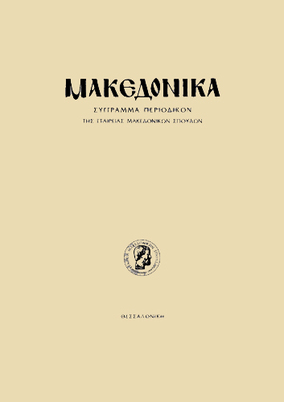Ανασκαφή προϊστορικού οικισμού νεότερης νεολιθικής και πρώιμης εποχής σιδήρου στον λόφο της Αγίας Λυδίας Ασπροβάλτας
Part of : Μακεδονικά ; Vol.32, 2000, pages 393-441
Issue:
Pages:
393-441
Parallel Title:
Excavation of a Prehistoric Settlement of the Late Neolithic Era and Early Iron Age on St. Lydia’s Hill, Asprovalta.
Section Title:
Articles
Abstract:
The prehistoric settlement of St. Lydia lies on top of an isolated hill 155 m. high at the northern end of the Asprovalta plain. The section of the plain to the south-west of the hill has been formed by alluvial deposits with a high sand and gravel content, which means the soil is not particularly productive. The exploratory excavation that was carried out in the summer of 1996 brought to light three construction phases, of which the two most recent ones (phase 3 and phase 2) date from the Early Iron Age, while the oldest one (phase 1) dates to the Late Neolithic Era. Two successive trenches, 4x4 m. in size, were excavated on the NE side of the plateau of the hill. In construction phase 3 the east wall of a building and the remains of two hearths were uncovered. A larger hearth that was uncovered to the east of the wall appears to have been situated in some external area of the house. The excavation of construction phase 2 revealed part of a wall which, on the basis of the ex cavation data, also appears to have formed part of the east wall of a house. The pottery from the Early Iron Age is mainly coarse ware, while there is a smaller quantity of pots with polished interiors. Burnished black and red pots are very few in number. The fill of construction phase 1 has been very largely destroyed by the Early Iron Age buildings. In this phase eight pits were uncovered which were probably used for storage purposes. In all of the construction phases that were uncovered it was found that the construction of the buildings had been preceded by ground-flattening oper ations, which created a sequence of different levels. Most of the Neolithic pottery consists of sherds of coarse ware (cat. 4). There are relatively high proportions of black burnished pots and pots of the black-on-red variety. Incised pots (cat. 13) are relatively few in number, and include pots with successive striations (cat. 20), pots with impressed decoration (cat. 21), and pots painted crimson on creamy yellow (cat. 30) or red on brown. Amongst the small finds from phase 1 stand out a bronze fibula and a clay seal.
Subject:
Subject (LC):
Notes:
856:https://ejournals.epublishing.ekt.gr/index.php/makedonika/article/view/5739, DOI: https://doi.org/10.12681/makedonika.178
Electronic Resources:




